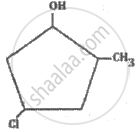Advertisements
Advertisements
प्रश्न
Give the structure for the following compound.
Octane - 1,3- diene
उत्तर

APPEARS IN
संबंधित प्रश्न
Identify a more favourable resonance structure from the following. Justify.

Match the pairs.
| Column 'A' | Column 'B' | ||
| i. | Inductive effect | a. | delocalisation of π electrons |
| ii. | Hyperconjugation | b. | displacement of π electrons |
| iii. | Resonance effect | c. | delocalisation of σ electrons |
| d. | displacement of σ electrons | ||
Phytane is a naturally occurring alkane produced by the alga spirogyra and is a constituent of petroleum. The IUPAC name for phytane is 2,6,10,14-tetramethylhexadecane. Write a zig-zag formula for phytane. How many primary, secondary, tertiary, and quaternary carbons are present in this molecule?
An electronic displacement in a covalent bond is represented by the following notation.

A. Identify the effect
B. Is the displacement of electrons in a covalent bond temporary or permanent.
In the hydrocarbon
![]() the state of hybridisation of carbon 1,2,3,4 and 7 are in the following sequence.
the state of hybridisation of carbon 1,2,3,4 and 7 are in the following sequence.
Which one of the following names does not fit a real name?
The IUPAC name of the compound\[\begin{array}{cc}\ce{CH3-CH=C-CH2-CH3}\\
|\phantom{..}\\\phantom{...............}\ce{CH2 - CH2 - CH3}\end{array}\] is
Give the IUPAC names of the following compound.
\[\ce{(CH3)2 CH–CH2 –CH(CH3 )–CH(CH3)2}\]
Give the structure for the following compound.
3 - Chlorobutanal
What is the IUPAC name of the following compound?

